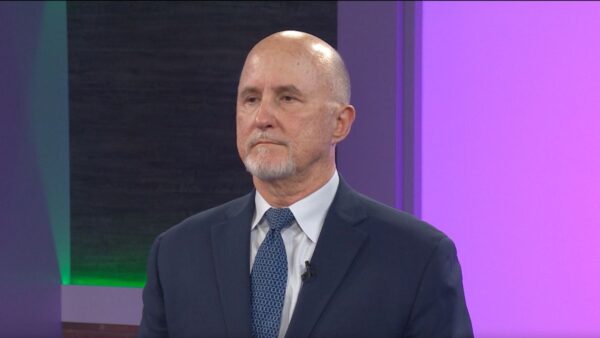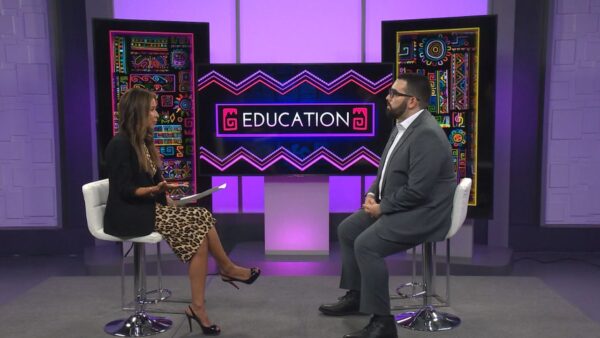The Behavior Research Center and ArtsMarket prepared a study for Maricopa Partnership for Arts and Culture. The study hopes to gain an understanding of the Latino arts and culture consumer market and the factors that impact their participation in arts in the valley. The Behavior Research Center along with Ricardo Torres, Publisher/CEO of Latino Perspectives Magazine join HORIZONTE to talk about the results.
>> José Cárdenas:
Good evening and welcome to Horizonte. I'm José Cardenas. A look at arts, culture, and Latino consumer, how the results of one study could reveal what the Hispanic market is like when it comes to culture and arts and also the factors affecting their level of interest and participation. And a special organization honoring the memory of a child who died of leukemia, how her legacy lives on providing other children and families comfort while undergoing treatment at a Valley hospital. These stories coming up straight ahead on Horizonte.
>>Announcer:
Funding for Horizonte is provided by S.R.P. "S.R.P.'s business is water and power. But our dedication to the community doesn't stop there. S.R.P., delivering more than power."
>> José Cárdenas:
The greater Phoenix region has many arts and culture events and activities for everyone throughout the year. The Hispanic segment of the population continues to be of great interest to the region's arts and culture community. There was need to understand this audience. Now in a study just released that focuses on the Latino market, who they are, and factors influencing their participation in the arts and culture scene here in the Valley. Horizonte's Mike Sauceda reports on some of the results.
>>Mike Sauceda:
The Behavior Research Center and Arts Market in conjunction with the Maricopa Partnership for Arts and Culture (or M-PAC) released an unprecedented study which focuses on local Latino participation in the arts. The arts culture and the Latino audience studies found Valley Latinos spend $118 million on arts and culture. The study focused on 22 cultural events from amusement parks and Broadway shows to Latino and non-Latino entertainment.
>>Mike Sauceda:
The study groups were divided into three categories: learners, those who speak only Spanish; straddlers, the bilingual speaking Latinos; and finally the trend setters, the English only speakers. The study found Latinos spend a substantial amount time at numerous events, 58% attend zoos and botanical gardens, and 61% enjoy visiting amusement parks and state fairs and carnivals. The study also shows that 22% go to exhibitions and galleries while 41% enjoy attending museums. A smaller percentage, 10 to 15%, attends plays, opera, symphony, and pop events. The study looked into what motivates Latinos to participate in the arts. It concluded Latinos enjoy participating in family friendly activities but are hesitant when it is a costly event. 60% said they believe attending a family event is what they should do and would do. But if they had to pay several hundred dollars for an activity, only 41% said they would.
>>Mike Sauceda:
Perhaps most revealing about the study is Latinos find culture and entertainment an important part of their lives. Nine out of 10 said Latino entertainment is important to them and eight out of 10 say non-Latino entertainment is of interest to them. When asked if the price of an event is the main reason for deciding to take the whole family to an activity. The majority said yes. According to the study, 14% of Latinos polled said they attend only one big event a year. And 27% said they will a tend two events a year and would also attend smaller events. The study concluded that local Latinos are large donor based in the area of arts and culture, and if marketed correctly, it can result in increased attendance and revenue.
>> José Cárdenas:
Joining me to talk about this study is Ricardo Torres, publisher and CEO of Latino Perspectives Magazine and Earl de Berge, Research director for the Behavioral Research Center. Gentleman thanks you for joining me on Horizonte--You've both been here before.
>>Ricardo Torres:
Thank you.
>> José Cárdenas
Good to have you back, Ricardo. This particular project is one that you had a hand in, at the very beginning. Tell us first what "Impact" is and what role you played in getting the study off the ground.
>>Ricardo Torres:
Impact" is a local nonprofit organization whose primary goal is to promote arts and culture and to really build an understanding of the role arts and culture plays in the economic prosperity of this region. For me my involvement with them began a few years ago after I launched Latino perspectives magazine. We really started talking about the diversity of the Latino market and one of the conversations I had with them this is something you really have to study. And this study that was released today is just a great road map that really provides the first road map from an independent research institution such as Behavioral Research Center that really gives us a good understanding of how diverse the Latino market is, and how you have to look at it within the diversity and see what part of the market best fits the product, service, that you are wanting them to be aware of.
>>José Cárdenas:
And I want to get into a lot of the details, but first, Earl, in the video piece we saw; Mike Sauceda described the study as unprecedented. What did he mean by that?
>>Earl de Berge:
Well, to the best of our knowledge, no study of that just focused on the Latino market and how it orients itself to cultural opportunities and artistic opportunities in the community has ever been done before.
>>José Cárdenas:
Not even by the Hispanic Research Center?
>>Earl de Berg:
Apparently not. And I know inquiries have been made of them as to whether or not they've done a study like there and they have said not, as well. So this is a ground breaking study just to focus very, very closely on this market and see how it operates.
>>José Cárdenas:
Tell us how the study was put together.
>>Earl de Berg:
The study was put together using very strict random sampling of the community including cell phones so we could cover that base. The idea was that we had to look at all Latinos regardless of their level of acculturation, in order to really understand the size of that market. We've seen some other studies in which they only interview those who are active consumers of arts and cultural activities. Problem with that approach is it really doesn't allow to you correlate your data back to the total market and also then to the media available for organizations that are trying to reach that market with their messages.
>>José Cárdenas:
In effect you're preaching to the choir, those are the people that you sample.
>>Earl de Berg:
Right. And what we found here really is pretty remarkable. This is a very, very involved market. We've got something like 41% of households who say that we're willing to define as core consumers, either go on demand. They have the wherewithal to go to whatever they want to whatever the price is. Or they go to a lot of smaller events and save up for big events. So we have four of 10 households are actively involved in the Latino community in participating in and spending money on arts and cultural events in this community.
>>José Cárdenas:
Tell me again the sample size.
>>Earl de Berg:
1,200 households.
>>José Cárdenas:
And these were people who self-identified as Latino?
>>Earl de Berg:
That's correct, that's the definition we use and one we recommend because it's really the cultural orientation that defines the Latino, rather than whether parents or great grandparents or beyond that parents were born somewhere in the Hispanic Americas or in the Hispanic world.
>>José Cárdenas:
You started to touch upon how complex this group really is. Give us some more examples.
>>Earl de Berg:
Well, in addition to the normal definitions you'd make about culture, excuse me, about gender and age and income and so on, what we're finding in our studies, this one as well, you need to think about the Latino community not as a monolithic group, but as having at least three major segments that define your marketing attack and media attack and this has to do with what is probably the principal definer of acculturation, that's language skill. And we recognize the people who are Spanish dominant. That is to say they depend on Spanish in order to communicate and work in the marketplace and live in the marketplace, about 35% of the total. Then there's a group called bilingual, which literally are comfortable in either environment, either in the media or in their workplace or their homes. And then finally the segment that is English dominant. The latter two, bilinguals and English dominant are the majority of the population being the opposite of the 39%. The Spanish language segment is well served by Spanish language media here, extremely well served. Focus groups and research great awareness, get lots of information from those media, works well for them. It does not work well or as well for the bilingual and English dominant people. They really rely on English language media for information about what's available to them in the market place.
>>José Cárdenas:
And these three groups correspond roughly to the categories of learners, straddlers, and trend setters?
>>Earl de Berg:
They do in a general sense. We have started using the term learners and straddlers and trend setters to help people who are marketing understand them, not just in terms of demographic characteristics but in terms of who they are as consumers. Learners are just exactly what it sounds like, people new to the culture, trying to figure out where they are in it, what's available to them, what their choices are in a new market. Imagine yourself moving to a foreign country and not speaking the language, you're going to have to do exactly the same thing for food, entertainment, for all those kinds of things. The fully acculturated person, the trend setter who says I'm Latino, proud of it, and I have great affection for the language and the culture. And in between those two are the people who stepped out of being totally dependent on Spanish or totally dependent on English and have their foot in both camps and they're really redefining themselves in the world that they live this. And if you can think about the marketplace that way, you have a better chance of then orienting the product that you're trying to sell to that market. If you're selling product that is basically for Spanish speakers, you need to be in the Spanish language media. If you're looking at the product or programs that are bilingual or music, whatever, what we have discovered in this study is you can rely mostly on communications in English to reach those people and reach them effectively.
>>José Cárdenas:
Ricardo, much of this is not news to you. Is it news to the business community at large? Haven't they been doing this kind of segmentation all along, at least for the last maybe decade?
>>Ricardo Torres:
Some have, and what we've seen out of the marketplace is that most of the focus has been as Earl said in the Spanish language dominant side. I think one of the important things in the study that it brings out is even what the study defines as trend setters, who, you know, very acculturated, English dominant, still very bilingual, by the way. Or they retain some bilingual capabilities. But what we have always known and understood about the Latino market and about Latinos who are second or third or fourth generations is the closeness they feel, the attachment they look for, to the culture, the things that make them feel Latino. And that is one of the greatest validations I think that this study does, is that even Latinos who are out there who don't speak a word of Spanish, they still self-identify as Latino, and so I think the message that this study gives out is that yes, it is important to identify which of these groups you're going to reach, and then it's important to reach the group if indeed you are going to be reaching the trend setters, to understand that you need to reach them in a culturally sensitive context, acknowledge the culture, they respect this, they look for this, they respond to this. And this is something the study really brought out.
>>José Cárdenas:
$118 million that they're spending already, was there any analysis given to what that potential market could be, if it's really cultivated?
>>Ricardo Torres:
According to the study, what the study says is that they are right now consuming half of what the potential is. This means that the potential might be closer to $250 million. Just depends how you reach them, what language you reach them in, and what media you use to reach them.
>>Earl de Berg:
And it also depends on your willingness attack some of the perceptions about what's available in the arts community. They do have-there's a disconnect between what Latinos think it costs to go to these kinds of events or what perhaps what kind of dress they have to do or even where the outfits are. Compared to what the reality is. We went into focus groups and put the brochures of arts organizations in front of them, there was suddenly realization that, hey, I didn't know that existed. I didn't know I could afford it. It's in my range of affordability and so on. So there's some really basic marketing strategies that arts organizations need to consider when they reach out to this community to provide that information for them. The other thing we've done is the cultural sensitive issue, and that is paying more attention to putting an image in the mind of the potential consumer that they're wanted, that the audience, they're valued as members of the audience. This may be a handicap that applies beyond the Latino community. If you look at most arts organizations publications you'll see they tend to be product oriented almost exclusively. There is a need to say we understand the audience and want you as customers.
>>José Cárdenas:
Ricardo, Earl was talking about some of the misperceptions the Latino market has in terms of what's available and what it would cost. What about misperceptions by the mainline cultural institutions like the opera, the symphony, and so forth, as to the level of interest in the Latino community?
>>Ricardo Torres:
That was one of the things the study looked at, and that is something that's been out there. You know, for years and years being in the media for the last three years I always heard, well, I try to do this campaign for the Latino community or for the Latino market and it just didn't work. Well now we actually have documented proof that shows why it didn't work and road map to make it work better next time. And one of the interesting things of the findings are, and there's so many that we don't have enough time to go through all of them or talk about all the different things that this study has identified, but I think that one of the most important things that the study has done is not just provide road map or a framework in which to work in to reach various segments of the Latino market you want to reach, not just for the arts and culture community, but I think there's a lot of valuable information in this report that can be used for many other industries. So really this study we should be very proud that it happened here, that we were the first ones to really focus on it and really put numbers to it and really understand it. But the study provides a lot of valuable information that could be used across many industries. This is just the start.
>>José Cárdenas:
And on those notes of pride and value, we'll have to end our interview, Ricardo Torres, Latino Perspectives.
>>Ricardo Torres:
Thank You.
>>José Cárdenas:
Earl de Berge, Behavioral Research Center, thanks for joining us on Horizonte.
>>Earl de Berg:
Thank you.
>>José Cárdenas:
One father's loss of a child turned into a special legacy that lives on today through helping families and children fighting life-threatening diseases. Nadine Arroyo Rodriguez introduces you to Angelita's Amigos.
>>Nadine Rodriguez:
At St. Joseph Hospital in Phoenix, Angelita's Amigos have a place they can call home. Angelita's Amigos is a Valley organization founded by Angela Grace Olivas family after she lot her battle with Leukemia at age four. Originally the organization helped support families of cancer stricken young patients and helped fight the disease. During the last few years it has expanded to literally helping families from the moment they walk into hospital. Bob Olivas, Angela's father, has made it the family's mission to assure families of critically ill pediatric patients have the comforts of home in their rooms. The organization with the support of the hospital, have transformed numerous pediatric hospital rooms into a family friendly atmosphere, each specifically decorated. Hardwood floors, bright colored walls, specially treated windows, ceiling panoramic views, and key amenities for overnight stays.
>>Bob Olivas:
If I can accommodate the family and allow their stress to be reduced by having the opportunity to stay in a room that does not look like a hospital room but more like the Marriott, more like a family friendly room, a room that they can bring stuff from home and refrigerator and entertainment center, they can come in and watch their regular programs that they love to see, DVD's, whatever. And also giving them the opportunity to just fight this disease together as a family. And that was the most important thing to me.
>>Nadine Rodriguez:
It was in this tiny room now converted into an office that Angela and her family spent days and nights, while she underwent chemotherapy. Olivas recalls those painful days, their daughter seriously ill and the family feeling as though the walls were caving in on them. After her death, her family decided they never wanted another family to feel that same agony. So through the help of donations, several rooms were transformed into Angelita's Amigos rooms.
>>Bob Olivas:
We are very fortunate that the hospital has grown and Angelita's Amigos has grown with them. My vision is to go ahead and continue opening up these rooms for the family in need that, again, it's all about family. And I believe that as you go through some of the negatives of life, you fight it as a unity, that's what the rooms are all about.
>>Nadine Rodriguez:
Young patients and families who have stayed in one of the rooms say Angelita's Amigos rooms are a blessing.
>>Marisa Medrano:
Just helps us to deal with the stress, you know, of what he's going through, it helps him too a lot, you know, he thinks he's -- it's like a home setting, you know. We're not -- we know we're at a hospital but it's not as bad.
>>Bob Olivas:
I try to tell the people that come to these rooms that you're not alone. You have got a network, starting with Bob Olivas. All the way through. That you're not fighting this by yourselves. Angela Grace Olivas was born in Phoenix. And Angela's death becomes to me basically like the Phoenix bird. She has risen, she has given us strength, and she supports those people in need especially her brothers and sisters that have to utilize this bed.
>>José Cárdenas:
Joining me to talk about how Angelita's Amigos started and what her legacy has become at the hospital is Robert Hopkins vice president of St. Joseph's Hospital and Barrow Neurological Foundations, Dr. Hopkins, thanks for joining us on Horizonte.
>>Robert Hopkins:
Well what a pleasure it is to be able to talk about this program to a wider audience.
>>José Cárdenas:
And what a great story this is. We got a sense from the video as to the personal tragedy that was the genesis of this. But how did they present it to the hospital in the foundation in terms of just getting this program off the ground?
>>Robert Hopkins:
Right. Well, this really is a tribute and honor to Angela Grace Olivas. As you heard in the earlier segment of the program, she died in 1986 of Leukemia and she was in what is now at St. Joseph's the old part of our pediatric floors and they're all small, relatively small, double rooms by and large, very few laboratories in the room, and really not family friendly at that time. This building was built in the early ‘50s; people who have been around this town for a long time remember the old St. Joseph's right on Thomas. And indeed that's still I mean part of our pediatric program. However, the rooms have been continually upgraded and refurbished and what Bobby and Joanne decided at Angela's death was that -- because they were spending 24/7 in that small room, and they made a commitment really to themselves and to their friends and later to us that they were going to do something about it and if you will, change the world one room at a time, which really they have done. And they have decided that no other parent should have to be uncomfortable or be restricted in any way from spending that quality time with a very sick child. And so they went about the business of incorporating Angelita's Amigos in 1988.
>>José Cárdenas:
They did this all on their own?
>>Robert Hopkins:
All on their own. This is as grass roots a program as you can find.
>>José Cárdenas:
How is the money raised?
>>Robert Hopkins:
The money is raised really through one extraordinary golf event that's held each May out in the West Valley. It started with really a handful of foursomes about 13 years ago and I had the privilege of playing in it in may of this year, and there were 360 golfers or thereabouts with about 500 people joining us for dinner after, so it has really, really taken off and to their eternal credit, it's been sustained over these 20 years.
>>José Cárdenas:
And how much money typically would you raise at one of these events?
>>Robert Hopkins:
I believe that Bobby and his board, there's a 10-person board, netted about $35,000 this time. They have raised well over 150,000 over the years and extraordinarily enough, just pledged another quarter of a million dollars to begin to retrofit, refurbish, and be a partner with St. Joseph's into the future.
>>José Cárdenas:
What does it cost to do this retrofitting?
>>Robert Hopkins:
Well, the old part of the hospital, and I keep referring to that part, the chassis built in the early '50s. This he were double rooms, so to transform them to a private room with bath and with all the accouterments you would want to stay inch a very comfortable setting, it's 13, 14, $15,000 per room. If we were building a room from scratch, it would cost multiple times that of course, but we are retrofitting the existing rooms.
>>José Cárdenas:
How many do you have now?
>>Robert Hopkins:
So far they have done seven of these rooms, really transforming them, nothing short of a transformative experience for the peds floor, as well as create three treatment rooms and refurbish those and make them much more child friendly.
>>José Cárdenas:
So the rooms for the parents they basically you have the patient bed and then you have a place for the parents to sleep and so forth.
>>Robert Hopkins:
There's a day bed, very comfortable lounge chairs, refrigerator, private bathrooms, changing area, very comfortable PlayStation and console with all kinds of entertainment equipment for the kids and the family.
>>José Cárdenas:
Tell us about the treatment rooms. I understand you've had some pleasant surprises there in terms of the impact it's had.
>>Robert Hopkins:
Yes, indeed. Apart from making them child friendly and part of that involves -- we need a child life specialist here to explain it more accurately, but to defuse as much as possible the anxiety about going in for a procedure of some kind. So what part of the money of Angelita's Amigos has done is enable us to purchase these extraordinary ceiling tiles. And it's basically a wonderful photograph that's reproduced as the sky, clouds, treetops, and so forth. And it's very attractive. Well, it turns out that it's also a wonderful distraction for the children receiving a treatment and so the pediatricians tell us that often the time needed to do a procedure and exam has been reduced. The level of anxiety has been diminished; the child undergoes that treatment in a much more -- much faster way, and with less trauma.
>>José Cárdenas:
So a real therapeutic benefit?
>>Robert Hopkins:
There's a therapeutic value to the tiles.
>> José Cárdenas:
We put the website there and people can get more information about the program by going to it. But we've got about 30 seconds left. What can we expect to see in the future in terms of collaboration between St. Joe's and Angelita's Amigos?
>>Robert Hopkins:
It's nothing -- it's not an exaggeration to say the Olivas family has become part of our family. It may sound trite but it's an absolute fact. Bobby and his brother Louie, Dr. O, will go down the hallway and believe me most people know them at the hospital.
>>José Cárdenas:
And they know them very well here as well because of Dr O's presence on the campus. We'll have to end the interview there but thanks for joining us.
>>Robert Hopkins:
Thank you for having me. I appreciate it.
>>José Cárdenas:
You may have seen her on television or read her books and columns; we introduce you to the crafty chica Kathy Cano Murrillo at 7:30pm next Thursday on Horizonte. I'm José Cardenas. Thanks for joining us, have a good evening.
Ricardo Torres: Publisher and CEO, Latino Perspectives Magazine ;




















